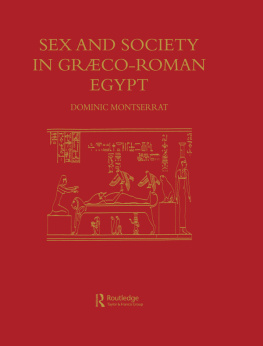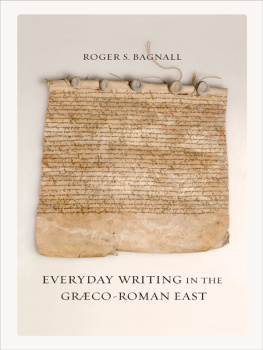SEX AND SOCIETY IN GRCO-ROMAN EGYPT
SEX AND SOCIETY IN GRCO-ROMAN EGYPT
DOMINIC MONTSERRAT

First published in 1963 by
Kegan Paul International
This edition first published in 2011 by
Routledge
2 Park Square, Milton Park, Abingdon, Oxon, 0X14 4RN
Simultaneously published in the USA and Canada
by Routledge
711 Third Avenue, New York, NY 10017
Routledge is an imprint of the Taylor & Francis Group, an informa business
Dominic Montserrat 1996
All rights reserved. No part of this book may be reprinted or reproduced or utilised in any form or by any electronic, mechanical, or other means, now known or hereafter invented, including photocopying and recording, or in any information storage or retrieval system, without permission in writing from the publishers.
British Library Cataloguing in Publication Data
A catalogue record for this book is available from the British Library
ISBN 10: 0-7103-0530-3 (hbk)
ISBN 13: 978-0-7103-0530-5 (hbk)
Publishers Note
The publisher has gone to great lengths to ensure the quality of this reprint but points out that some imperfections in the original copies may be apparent. The publisher has made every effort to contact original copyright holders and would welcome correspondence from those they have been unable to trace.
PLATES
between pages 76 and 77
FIGURES
Acknowledgements
It is a pleasant duty to acknowledge all the friends who read and commented on sections of this book, provided interesting ideas for questions to discuss, and gave general support while I complained about writing: Richard Alston; Kate Chedg- zoy; Desbina Christoudoulou; Mike Davis; Joyce Filer; Jane Fisher; Matthew Fox; Rebecca Flemming; Lucia Gahlin; Matthew Leigh; Herwig Maehler; Elinor Mason; Jessica Maynard; Lynn Meskell; Penelope Murray; Burhan Tufail; Richard Parkinson; Geraldine Pinch; Jonathan Walters; Margaret Williamson. An even greater debt is owed to Catherine Alexander who tried to brush up my anthropology; Peter Davidson who translates so sensitively; Jane Stevenson, doctisissima puella, who provided the drawing of Eros and Psyche in ; Helen White- house who provided the original for Plate 12; and last, though his contribution was the greatest, Terry Wilfong. In spite of all their help, any mistakes remain my own. Special thanks go to the eternally patient, helpful and courteous staff of the Institute of Classical Studies (Naomi Alvarez, Colin Annis, Joanna Ball, Paul Jackson and Susan Willetts), who dealt with all my unreasonable requests; to my co-workers in the Department of Classics and Ancient History at Warwick University; and to my parents Angela and James who did all the things that parents are supposed to do when their offspring has a crise de foie. Many thanks indeed to Bram Calcoen who provided some of the excellent drawings, and all the institutions and individuals who were kind enough to give permission to reproduce photographs. At Kegan Paul, the editorial director Kaori OConnor enthusiastically supported the work from its inception, and the editor, Carol Gardiner, saw it through the press. This book would never have happened without them. Postremo has litteras ad memoriam J.P.S., qui me impellit hanc opusculum conficere, dedicati sunt; heac olim meminisse iuvabo (Vergilius).
Conventions used in the Text
Chronology
All the dates given for the pre-Ptolemaic period, and some of those later, are approximate. Since little reference has been made to historical periods before the New Kingdom or the so-called intermediate periods between the main historical divisions, only the broadest chronological suggestions have been given. The reigns of the Ptolemies have also been simplified, usually ignoring complex co-regencies, de-thronements and restorations. No Roman emperors between 235 and 284 CE are mentioned; this was a crisis period when the throne was frequently contested, and it would be otiose to list the numerous emperors. Those requiring further information are referred to E. J. Bickerman, Chronology of the Ancient World (revised edition, London 1980).
Archaic period | c. 31002686 BCE |
Old Kingdom | c. 26862181 BCE |
Middle Kingdom | c. 19911786 BCE |
New Kingdom | c. 15671085 BCE |
18th Dynasty | c. 15671085 BCE |
19th Dynasty | c. 13 201200 BCE |
20th Dynasty | c. 12001085 BCE |
Saite Period | c. 945525 BCE |
Persian period | c- 525332 BCE |
Alexander the Great | 332323 BCE |
Ptolemaic Period |
Ptolemy I | 305282 BCE |
Ptolemy II | 285246 BCE |
Ptolemy III | 246222 BCE |
Ptolemy IV | 222205 BCE |
Ptolemy V | 205180 BCE |
Ptolemy VI | 180145 BCE (expelled 1634; restored) |
Ptolemy VII | |
Ptolemy VIII | 145116 BCE |
Ptolemy IX | 11681 BCE (expelled 107, restored) |
Ptolemy X | 10788 BCE |
Ptolemy XI | 80 BCE |
Ptolemy XII | 8051 BCE (banished between 58 and 55) |
Ptolemy XIII | 5147 BCE |
Cleopatra | 5131 BCE |
Ptolemy XIV | 4742 BCE |
Ptolemy XV | 3631 BCE |
Roman Period |
Augustus | 30 BCE-14 CE |
Tiberius | 1437 CE |
Gaius Caligula | 3741 CE |
Claudius | 4154 CE |
Nero | 5468 CE |
Galba, Otho, Vitellius | 689 CE |
Vespasian | 6979 CE |
Titus | 7981 CE |
Domitian | 8196 CE |
Trajan | 96117 CE |
Hadrian | 117138 CE |
Antoninus Pius | 138161 CE |
Marcus Aurelius | 161180 CE |
Commodus | 180192 CE |
Pertinax, Didius Julianus | 1923 CE |
Septimius Severus | 193211 CE |
Caracalla | 211218 CE |
Elegabalus | 218222 CE |
Severus Alexander | 222235 CE |
Crisis Emperors | 235284 CE |
Diocletian | 284304 CE |
Constantine | 306337 CE |
Christian Emperors at Byzantium | 337641 CE |
Muslim Invasion | 641 CE |
Calendar
All dates are to before or after the Common Era (BCE/CE). In general, I have not given Julian calendar equivalents to Egyptian month names in the running text unless they are particularly important to the argument. In documents, years were usually dated by the regnal year of the current ruler, who was given a full honorific titulary. For instance, the full titles of Marcus Aurelius were Imperator Caesar Marcus Aurelius Antonius Augustus Armeniacus Medicus Parthicus Maximus. I have simplified these by referring to the simplest and most recognisable form of the name.
Next page










